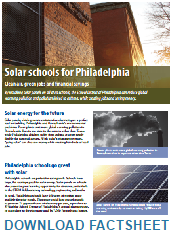Gideon Weissman
Former Policy Analyst, Frontier Group
David Masur
Solar energy is booming across the country, and with good reason. Solar panels generate emission-free energy, at a price increasingly competitive with electricity generated from dirty fossil fuels. Philadelphia’s schools, taxpayers, and environment would benefit from an effort to put solar panels on every Philadelphia school.
Philadelphia’s public schools could cover nearly 40 percent of their energy needs by installing solar panels on their more than 100 acres of usable rooftop space. “Going solar” would save taxpayers tens of millions of dollars on electricity bills for school buildings, while creating local jobs, offering educational and training opportunities for city students and reducing pollution.
Solar panels and Philadelphia schools go great together:
- Solar energy can help Philadelphia reduce global warming pollution from power plants. Pennsylvania power plants emit the second-most global warming pollution of any state in the country.
- Solar energy is increasingly cost competitive with fossil fuel energy. From 2009 to 2013, large non-utility solar energy systems dropped in price by more than half.
- Solar energy provides budget certainty for school administrators and protects taxpayers against the highly volatile costs of fossil energy.
- Solar panels on schools present a great learning opportunity for students, particularly in the STEM fields – science, technology, engineering and math.
- Because schools use most of their energy during the day when the sun is shining, most solar energy they generate could be used on-site, which would increase reliability and reduce costs for schools and all Philadelphia consumers.
- Pennsylvania and Philadelphia policies – including strong net metering rules and the allowance of power purchase agreements – make Philadelphia a great place for an ambitious solar schools program. Federal policies create the opportunity for further savings.
Philadelphia schools have more than 100 acres of rooftop space available for solar panels. If every Philadelphia school installed solar panels on all available space:
- Solar panels could generate 71 gigawatt-hours of electricity per year, equivalent to 37% of the school system’s annual electricity use, or equivalent to the electricity used by 7,000 Pennsylvania homes.
- Solar panels could offset 62,000 metric tons of carbon dioxide emissions per year (equivalent to the annual emissions from 13,700 of today’s cars), along with 64 tons of smog-forming nitrogen oxide, and 127 tons of asthma-linked sulfur dioxide. Reducing harmful air pollution benefits Philadelphia’s children, who suffer from asthma at a rate nearly double the national average.
- Philadelphia taxpayers could save more than $13 million in 2016 dollars over the assumed thirty-year lifetime of the solar installation. That’s before accounting for federal, state and local incentives.
- The project could create the equivalent of 750 one-year local jobs that cannot be outsourced.
The Commonwealth of Pennsylvania, the City of Philadelphia and the School District of Philadelphia should work together to:
- Commit to putting solar panels on all Philadelphia schools to make the city a leader in clean energy production.
- Require that any extensive school renovations include plans to study the cost effectiveness of solar panels, and require that any new school buildings use solar panels.
Strengthen Pennsylvania’s statewide commitment to solar energy, including increasing the solar energy requirement of Pennsylvania’s Alternative Energy Portfolio Standard (AEPS), and requiring that all solar renewable energy credits be generated in-state.
Topics
Authors

